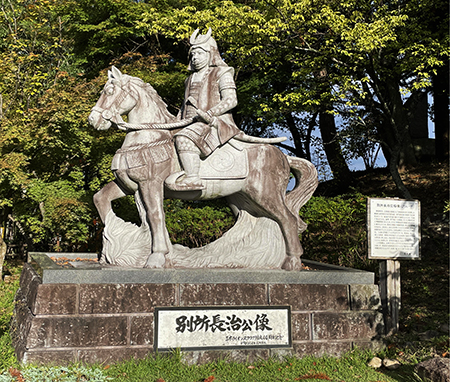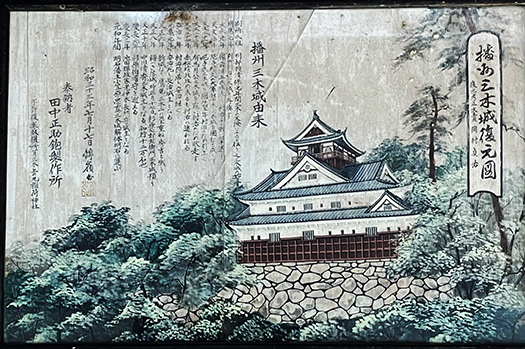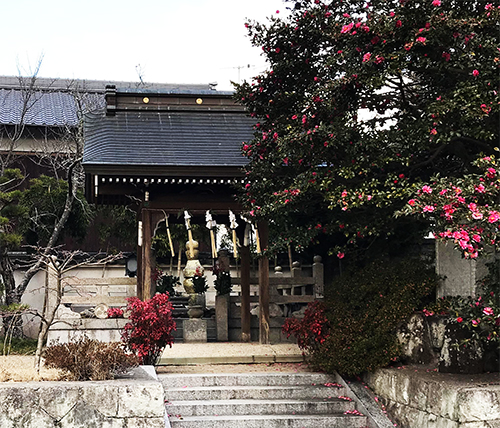


東播磨の要衝・三木城をめぐっての三木合戦は、天正6(1578年)5月5日から天正8(1580年)2月2日にかけて行われた。ここまでの播磨地域をめぐる政治軍事情勢では、畿内地域を押さえて安土城の築城にも手を付け始めた信長の織田勢力が、いよいよ西国制覇に取りかかり始めたのに対して、一方の中国地方の覇者・毛利氏もまた播磨に勢力を拡大させようとしていた時期に当たる。
まるで東西冷戦のなかのポーランドなどの様子と似た状況。さらに言えば今日世界で米中の覇権構図の中での東南アジア諸国、日本も含めた東アジア諸国のように、そもそもが不透明な状況の中で地域勢力として緩衝地帯として、織田・毛利への両属姿勢を決め込んで情勢観測に尽力していたのだろうと思える。現代の石破政権には確たる外交戦略眼はないように見えるが、さらにトランプが儀礼的電話会談を5分間で終了させたことから明らかなように、そもそも政権の正統性自体に疑問符が付けられているのが現実。おっと、横道すぎる(笑)。
そういうなかで黒田官兵衛のように織田・秀吉側一択で完全肩入れして、最終的に福岡・博多の領有に成功するような人物も現れたけれど、多くの地域勢力は右往左往してその多くが没落していった。この三木城の当主、別所長治という人物もまさにそういった典型と思える。
現地の「城跡」には凛々しい青年武将(自害当時23歳とも26歳とも伝わる)ぶりの騎乗の武者像が擬せられているけれど、2年にわたる籠城戦の間、何度かは包囲網に対して攻撃は仕掛けているが、戦略的な眼力があったかといえば疑わしい。籠城の城内に東播磨の兵士やその家族、浄土真宗の門徒など7,500人もの領民が蝟集した。いわゆる領民ごと立てこもる「諸籠り(もろごもり)」だった。ながく籠城するためには多くの兵糧が必要だがこれでは人数が多すぎる。こういった籠城戦での情勢戦略眼において秀吉の敵ではなかった。
戦略眼の乏しい主将に付き従って敗残した多くの領民は、しかしその後の歴史において追慕の念を持ち続け、写真のような脚色され美化された武将像を建立し、ありえないだろう「天守閣」図まで奉納している。司馬遼太郎の記述ではこうした追慕のあらわれから、明治になって三木城の故事が多くのひとびとに蘇って三木を姓とする庶民が多かったということにつながっているのだろうか。
主将別所長治はともに立て籠もった多くの領民の助命を条件として自害し果てたという広報、そのような人情話としての拡散が大きかったのだろうか。その後秀吉は三木の街の復興に尽力したとも伝わっている。実際に「三木の金物」という全国的にも有名な地域産業はこの復興事業の過程で生成していったとされている。あるいはそういった礎として美談話に昇華させる心理がひとびとに働いたのだろうか? 興味深い。
English version⬇
Oda and Mori, the front line in their East-West confrontation, attacked and defended Miki Castle.
The general of a country between two major powers is required to have a “strategic eye for the future,” but he tends to be biased toward emotion. The general’s eyesight was not clear enough to let even the common people enter the castle. What about modern Japan in retrospect? The future of Japan
The Miki Battle over Miki Castle, a strategic point in East Harima, took place from May 5, Tensho 6 (1578) to February 2, Tensho 8 (1580). The political and military situation in the Harima region up to this point was that Nobunaga’s Oda forces, which had seized the Kinai region and begun construction of Azuchi Castle, were finally starting to conquer the western part of the country, while the Mori clan, the Chugoku region’s dominant power, was also trying to expand its influence in Harima.
The situation was similar to that of Poland during the Cold War. In other words, the Mori clan was probably making efforts to observe the situation as a buffer zone as a regional power in an uncertain situation, just like Southeast Asian countries and East Asian countries including Japan under the hegemony between the U.S. and China. The reality is that the legitimacy of the administration itself is in question, as evidenced by the fact that Trump ended the ceremonial phone conversation after only five minutes. Oops, too sideways (laughs).
In such a situation, there were some people like Kanbei Kuroda who chose the side of Oda and Hideyoshi and succeeded in taking possession of Fukuoka and Hakata, but most of the regional powers went back and forth and many of them fell. Nagaharu Bessho, the head of Miki Castle, seems to be a typical example.
The “ruins of the castle” at the site show a gallant young warrior (reportedly 23 or 26 years old at the time of his suicide) riding a horse, but during the two-year siege, he launched several attacks against the encircling forces, but it is doubtful that he had any strategic acumen. As many as 7,500 local residents, including soldiers from Higashi-Harima, their families, and members of the Jodo Shinshu sect of Buddhism, gathered in the castle. This was what is called “morogomori,” in which the entire fiefdom was holed up in the castle. To stay in a castle for a long time, a large amount of food was needed, but the number of people in the castle was too large. Hideyoshi was no match for the foe in terms of strategic thinking in such siege warfare.
Many of the defeated fiefdoms who followed the strategically weak general have continued to hold on to their memories of him in later history, erecting statues of the warlord that have been dramatized and beautified, such as the one in the photo, and even dedicating a “castle tower” that would have been impossible to build. In Ryotaro Shiba’s account, the legend of Miki Castle was revived by many people in the Meiji era, and it is likely that this is what led to many common people taking Miki as their family name.
The public relations story of Nagaharu Bessho, who committed suicide on the condition that many of the local residents who had holed up in the castle with him would be spared, may have been widely spread as a human-interest tale. It is said that Hideyoshi made efforts to restore the town of Miki. In fact, the nationally renowned local industry of “Miki’s hardware” is said to have been created in the process of this reconstruction project. Or did people have a psychological tendency to sublimate such a story into a beautiful tale as a cornerstone of the project? It would be interesting to know.
Posted on 11月 11th, 2024 by 三木 奎吾
Filed under: 歴史探訪







コメントを投稿
「※誹謗中傷や、悪意のある書き込み、営利目的などのコメントを防ぐために、投稿された全てのコメントは一時的に保留されますのでご了承ください。」
You must be logged in to post a comment.